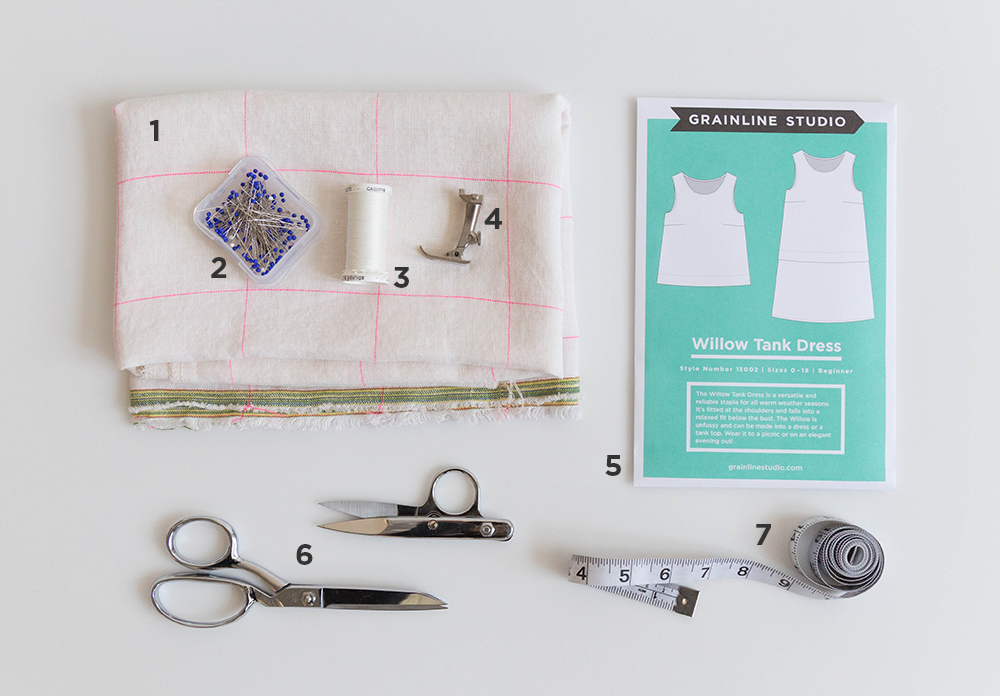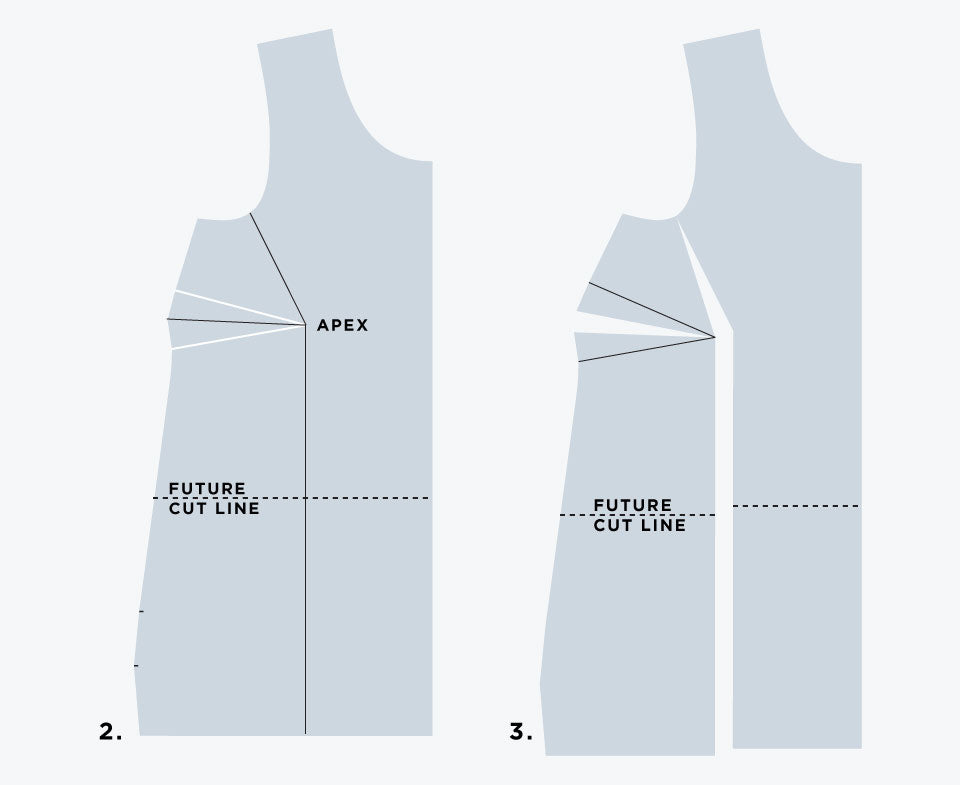
Today we’re finally starting the Willow Sew-Along! This pattern is rated Beginner so you more advanced sewers might not need this information, but I wanted to make sure that it’s readily available for anyone new to sewing who might need an extra hand.
To begin you’ll want to gather your supplies. I mentioned this in the Willow Sew-Along announcement post but if you missed that, for this pattern you’ll need the following:
- I’ll be using this Grid Linen from Purl Soho and Carolyn Friedlander’s Euclid Cotton/Linen for the sew along garments. You’ll find the yardage you need for your garment on the back of your pattern envelope.
- Pins. I like these super sharp Dritz glass head pins but grab whatever you’re used to using that’s appropriate for your fabric.
- Thread in a color that matches your fabric.
- I use my machine’s 1/4″ foot for the entire pattern.
- You’ll need the Willow pattern of course!
- Scissors. I use Gingher dressmakers shears as well as a thread snip kept by my machine.
- Measuring tape or ruler for laying out your pattern and to assist with the pleat if you’re making the dress version
Once you’ve gathered your supplies you’re going to need to find your pattern pieces. If you’re making the tank you’ll need pieces 1, 2, 5 & 6. For the dress you’ll need pieces 1-6. Below you’ll find diagrams on making some common pattern adjustments.

First up is lengthening and shortening the Willow. I’ll be showing the tank here, but the same method applies to any piece in the pattern.
1. Start by locating the pattern piece you need to adjust. Depending on what piece you’re altering there may or may not be lines to denote where you should lengthen & shorten between. If there are no lines, you can draw in your own.
2. Cut between the lines. With a piece of paper underneath the pattern, spread the two sections the amount you need to lengthen your piece making sure to keep the grain line of the two pieces aligned.
3. Trace your piece off onto the paper and re-blend any jagged edges along the side seam and repeat the adjustment to any affected pieces.

If you find that the torso is the correct length but you need to move the dart here are some easy steps to do so. We’re going to be moving the dart up in this tutorial but if you need to lower it you can do the opposite.
1. Draw a line through the bust point parallel to the CF/grain line. Place a mark along that line at the point where you need to lower the dart. If you need to raise the dart 1″ you would place the mark 1″ above the existing bust point.
2. Move the legs the same amount up from where they connect at the side seams. Reconnect the dart legs to the dart point.

3. You’re going to now need to fold the dart, since you’ve moved it the dart take-up is now in the wrong place at the side seam. Fold the dart so that the dart excess points down towards the waist and re-blend the side seam. Trim off the extra.
4. This is your new pattern.
Now lets talk Full Bust Adjustments. The Willow is drafted for a B cup (like all our patterns) so if you’re a C you may be able to get away without a FBA. The illustrations are cropped for better detail but any vertical lines should extend to the bottom of the pattern piece. If you’d like to do a small bust adjustment you would do the opposite of what I’m showing here. If you’re making the dress, don’t forget to make your adjustments to the skirt as well or the waistlines won’t sew together.

The first thing you need to do before you start your full bust adjustment is to figure out how much of an adjustment you’ll need. To begin you’ll need your upper bust measurement and your full bust measurement. Once you have those you’ll subtract your upper bust from your full bust. If the number you get when you subtract your upper bust from your full bust (the total adjustment) is over 2″ (B cup) you may need a full bust adjustment, whereas if the number you get is 2″ or under you’re either fine to use the pattern as is or you might consider a small bust adjustment. So if your full bust was 40″ and your upper bust was 36″ you’d subtract 40-36 to get 4″ which would require an adjustment.
Now you can take this new number and do one of two things with it. It seems to be the most common to just divide this number in half and apply that amount to each side of the adjustment shown below, so you would be moving the pattern 2″ in Step 3.
Your other option is to take your new number, in our case 4″, and subtract 2″ from it to get the full amount of your bust adjustment. Subtracting the 2″ comes from the fact that the pattern is drafted for a B cup which is a 2″ difference. Since this amount is already drafted into the pattern you are just adding the additional amount on top of what exists. You would then divide the full amount of the adjustment in half so you would be doing a 1″ adjustment on each side of the pattern.
1. Select your size based on your upper bust & waist measurements. Cut size.
2. Locate the apex of your bust and mark. Draw a line from the apex out to the side seam. Next you’re going to draw a vertical line from the apex down to the hemline of the pattern piece making sure to keep the line parallel to the CF / grain line. From there draw a line connecting the apex to the approximate center of the armscye. These are the lines that will form the full bust adjustment. Additionally you’re going to need a line across the torso, perpendicular to the CF / grain line in order to line the hem up in a future step. I made this one dotted so that it doesn’t get confused with the adjustment lines.
3. Slash through the waistline to the bust and up to the armscye taking care to cut to, but not through, the pattern at that point. You want to make sure that the two pieces are hinged together. Then slice through the line connecting the side seam to the apex, taking care to not cut through the apex point, you want the pieces hinged. You’ll then open the vertical slit the amount of your full bust adjustment making sure that the two edges of the opening are parallel.

4. You’ll notice that when you move the side out for the adjustment the side panel became longer than the piece you moved. Cut along the line you drew in step 2 and align the newly freed piece so that it’s even with both the center front and the dotted line on the side piece.
5. This method of adjustment will result in a larger dart being formed. To aide in creating expanded dart find the center of the dart legs and mark a line through the center of the dart (dotted line above). This will help you when folding the dart in the next step.

6. Fold the dart legs together with the takeup pointing towards the bottom of the garment and re-blend the side seam. I like to score the bottom dart leg and center line lightly with an awl to help the pattern fold right where you want it to on the first try. You can either cut across the side seam / dart or mark it with a pattern tracing wheel and cut when the dart is open.
7. Unfold the dart and cut out your new piece.

Now lay your pattern pieces out on your fabric according to the cutting layouts in your instruction booklets. Be sure to snip all your notches and mark your dart points. I also like to notch center front and center back to help with alignment later on.
That’s it for today, next up we’ll be sewing our darts and assembling our bodices!










